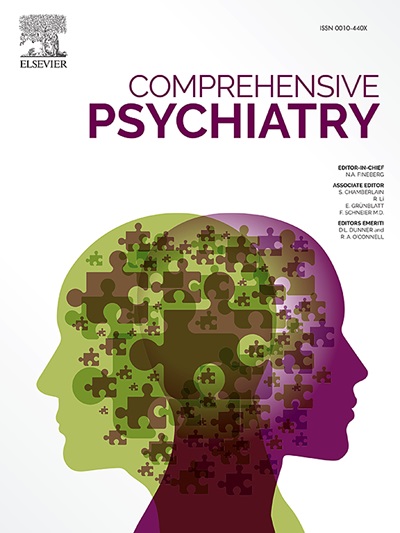Acceptability, tolerability and safety of the BRIGhTMIND trial: Connectivity-guided intermittent theta-burst stimulation versus F3- repetitive transcranial magnetic stimulation for treatment-resistant depression
IF 4.2
2区 医学
Q1 PSYCHIATRY
引用次数: 0
Abstract
Background
The BRIGhTMIND study was a double-blind RCT comparing repetitive transcranial magnetic stimulation at a standard simulation site (the “F3” location given by the International 10–20 system, F3-rTMS) versus connectivity-guided intermittent theta burst stimulation (cgiTBS) for treatment-resistant depression. This present study reports the acceptability, safety, and tolerability of F3-rTMS versus cgiTBS.
Methods
The present study used quantitative and qualitative methods. Two hundred fifty-four participants were included in the quantitative BRIGhTMIND acceptability and safety analysis (n = 126 F3-rTMS, n = 128 cgiTBS). Qualitative analysis included interviews for 15 participants (n = 7 F3-rTMS, n = 8 cgiTBS) and 582 written comments made by any participant randomised to the BRIGhTMIND trial regarding their experience of TMS and the study. Statistical analyses were used to explore differences between F3-rTMS and cgiTBS, as well as associations between acceptability, impression of change and safety. Qualitative data was analysed using an inductive thematic framework approach.
Outcomes
Acceptability, TMS benefits/negative effects and impression of improvement ratings did not differ across the two treatment protocols, with ratings maintained long-term (71.4 % rated TMS acceptable, 48.8 % indicated benefits of TMS outweighed negative effects and 52.2 % feeling somewhat or much better at 26 week follow-up n = 203). Impression of improvement was positively associated with acceptability and TMS benefits. Qualitative themes included participants' TMS experience, TMS response variability, and lay theories of effectiveness. Safety profiles were comparable between F3-rTMS and cgiTBS, with 74.5 % of participants (n = 190/254) experiencing at least one adverse event possibly, probably, or definitely related to TMS. The majority of adverse events were transient and mild, with a sizeable number requiring simple treatments or small adjustments to TMS intensity and coil positioning. The F3-rTMS group had a significantly greater proportion of participants that required small adjustments to TMS to tolerate treatment compared to the cgiTBS group. Serious adverse events were rare, with one serious event in each treatment arm possibly related to TMS (F3-rTMS- psychotic episode, cgiTBS-manic episode).
Conclusion
F3-rTMS and cgiTBS are comparably safe, tolerable and highly acceptable interventions for treatment-resistant depression. BRIGhTMIND systematically collected data from a large sample, providing evidence to meet the information needs of patients, clinicians and policy makers.
BRIGhTMIND 试验的可接受性、耐受性和安全性:连接引导的间歇θ-脉冲刺激与 F3-重复经颅磁刺激治疗耐药抑郁症的对比
背景BRIGhTMIND研究是一项双盲RCT研究,比较了在标准模拟部位(国际10-20系统给出的 "F3 "位置,即F3-rTMS)重复经颅磁刺激与连接引导间歇θ脉冲刺激(cgiTBS)治疗耐药抑郁症的效果。本研究报告了 F3-rTMS 与 cgiTBS 的可接受性、安全性和耐受性。254 名参与者被纳入 BRIGhTMIND 可接受性和安全性定量分析(n = 126 F3-rTMS,n = 128 cgiTBS)。定性分析包括对 15 名参与者(n = 7 名 F3-rTMS,n = 8 名 cgiTBS)的访谈,以及 582 份由任何随机参加 BRIGhTMIND 试验的参与者就其 TMS 体验和研究发表的书面意见。统计分析用于探讨 F3-rTMS 和 cgiTBS 之间的差异,以及可接受性、变化印象和安全性之间的关联。结果两种治疗方案的可接受性、TMS的益处/负面影响和改善印象评分没有差异,并且评分长期保持不变(71.4%的人认为TMS是可接受的,48.8%的人表示TMS的益处大于负面影响,52.2%的人在26周的随访中感觉有所好转或好转很多,n = 203)。改善印象与可接受性和 TMS 的益处呈正相关。定性主题包括参与者的 TMS 体验、TMS 反应变异性和非专业的有效性理论。F3-rTMS 和 cgiTBS 的安全性相当,74.5% 的参与者(n = 190/254)至少经历过一次可能、大概或肯定与 TMS 有关的不良事件。大多数不良事件都是短暂和轻微的,其中相当一部分需要简单治疗或对 TMS 强度和线圈位置进行小幅调整。与 cgiTBS 组相比,F3-rTMS 组需要对 TMS 进行小幅调整才能耐受治疗的参与者比例明显更高。结论F3-rTMS和cgiTBS是治疗耐药性抑郁症的安全性、耐受性和可接受性相当高的干预方法。BRIGhTMIND 系统地收集了大量样本数据,为满足患者、临床医生和政策制定者的信息需求提供了证据。
本文章由计算机程序翻译,如有差异,请以英文原文为准。
求助全文
约1分钟内获得全文
求助全文
来源期刊

Comprehensive psychiatry
医学-精神病学
CiteScore
12.50
自引率
1.40%
发文量
64
审稿时长
29 days
期刊介绍:
"Comprehensive Psychiatry" is an open access, peer-reviewed journal dedicated to the field of psychiatry and mental health. Its primary mission is to share the latest advancements in knowledge to enhance patient care and deepen the understanding of mental illnesses. The journal is supported by a diverse team of international editors and peer reviewers, ensuring the publication of high-quality research with a strong focus on clinical relevance and the implications for psychopathology.
"Comprehensive Psychiatry" encourages authors to present their research in an accessible manner, facilitating engagement with clinicians, policymakers, and the broader public. By embracing an open access policy, the journal aims to maximize the global impact of its content, making it readily available to a wide audience and fostering scientific collaboration and public awareness beyond the traditional academic community. This approach is designed to promote a more inclusive and informed dialogue on mental health, contributing to the overall progress in the field.
 求助内容:
求助内容: 应助结果提醒方式:
应助结果提醒方式:


